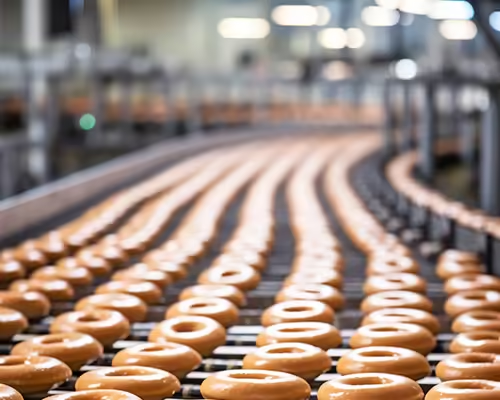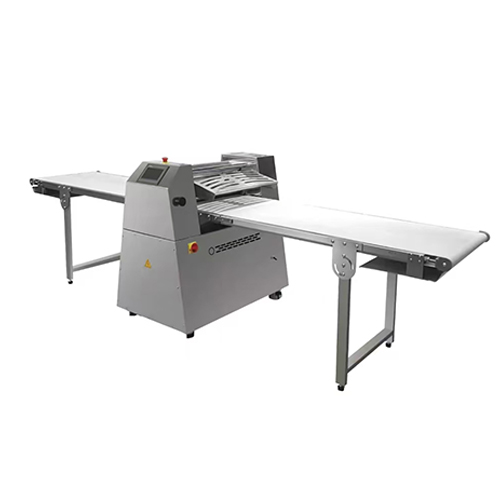


Scale your bakery with a thin bread production line. Discover how automation, precision, and smart solutions boost efficiency and profit.

For bakeries making thin breads like tortillas or pita, achieving consistent, high-quality products at high speeds is a major challenge. Slower, traditional methods create bottlenecks that limit growth and compromise quality. To meet market demands and stay competitive, a solution must be fast, reliable, and intelligent.
The answer is a high-speed thin bread production line. This is a seamless system, not just a group of machines. It optimizes every step, from mixing ingredients to cooling the final product, with a level of precision that ensures uniformity, minimizes waste, and maximizes output. This post will explore how a thin bread production line can transform your operations, improve product quality, and set your bakery up for long-term success.
The journey to a perfect thin bread starts with the dough. Consistent results require every piece of dough to be the exact same weight and size. In a high-speed thin bread production line, automated dividing and rounding systems handle this with no room for error.
These machines use precise volumetric or weight-based technology to cut a continuous dough sheet into perfectly sized portions. Each piece is then gently rounded into a smooth ball, creating a uniform foundation for the sheeting process. This attention to detail at the very beginning ensures that every final product is consistent in size, thickness, and weight, which is critical for even baking and a professional look. This level of precision is nearly impossible to achieve by hand, making it a key feature of any high-speed operation.
After the dough is divided and rounded, it must be flattened into a perfectly thin sheet without tearing. This is where advanced sheeting technology within a thin bread production line truly excels.
These systems use a series of rollers and conveyors to progressively and gently flatten the dough. Unlike a simple rolling pin, they apply uniform pressure across the entire dough surface, ensuring consistent thickness from the center to the edges. This “stress-free” sheeting process is vital for preserving the dough’s delicate gluten structure, preventing tears and bubbles that can hurt the final texture. The result is a smooth, uniform sheet of dough ready for baking, leading to a consistently perfect product every time.
A key feature of a high-speed thin bread production line is its ability to operate without interruption. Continuous flow systems are designed to eliminate bottlenecks, ensuring that dough moves smoothly from one stage to the next.
These systems use synchronized conveyors and automated transfers that maintain a steady pace throughout the line. The dough is automatically moved from sheeting to the oven, and from the oven to the cooling tunnel, all without manual handling. According to industry reports, a continuous production model can increase throughput by as much as 40-50% compared to batch-based operations. This non-stop process not only maximizes output but also ensures each piece of dough spends the exact right amount of time in each stage, contributing to a consistently high-quality final product.
For thin bread, baking time is often very short, but it has to be exact. A thin bread production line uses high-capacity ovens specifically designed for rapid, even baking.
These ovens typically have multiple zones, each with its own temperature and airflow controls. This allows for fine-tuning the baking process to get the ideal color, texture, and moisture content for a perfect product. The powerful heating elements and efficient air circulation ensure that heat is distributed evenly, preventing hot spots that can burn the edges or leave the center undercooked. With precise control and rapid baking cycles, these ovens can handle the high volumes the line produces, ensuring that baking never slows things down.
Maintaining quality is crucial, especially at high speeds. A modern thin bread production line uses advanced vision systems for automated quality control, catching imperfections a human eye might miss.
These systems use high-resolution cameras and advanced image analysis software to inspect every single piece of bread as it leaves the oven. The cameras can detect flaws like inconsistent color, improper shape, torn edges, or blisters on the surface. If a bun doesn’t meet the quality standards, the system automatically removes it from the line. This ensures only perfect, high-quality products make it to packaging, which significantly reduces waste and protects your brand’s reputation for excellence.
The final steps of a high-speed thin bread production line are just as important as the first ones. Proper cooling and efficient packaging are essential for keeping products fresh and ready for market.
A continuous cooling tunnel, built right after the oven, cools the buns to the ideal temperature for packaging without drying them out. This process ensures the buns are ready to be sealed immediately, which is crucial for extending shelf life. The cooled products are then automatically transferred to a high-speed packaging machine, where they are counted, stacked, and sealed with precision. This seamless integration eliminates manual handling and locks in the freshness of the baked product, providing a finished item that’s ready for distribution.
Investing in a high-speed thin bread production line offers a variety of benefits that go far beyond just increasing output. The table below outlines some of the biggest advantages for your bakery.
| Benefit Category | Description of Advantage | Impact on Your Bakery |
| Increased Throughput | Drastically higher production volume compared to traditional methods. | Allows you to meet large orders and scale your business without adding more labor. |
| Unmatched Consistency | Precise control over every step, from dough size to baking time. | Ensures every bun looks and tastes the same, building customer trust and brand loyalty. |
| Reduced Labor Costs | Full automation minimizes the need for manual handling and supervision. | Significant savings on wages, freeing up skilled staff for other tasks. |
| Minimized Waste | Precise dough portioning and automated quality control reduce raw material and product waste. | Cuts production costs and increases overall profitability. |
| Enhanced Food Safety | Automated, hygienic processes reduce human contact with the product. | Meets and exceeds food safety standards, protecting your brand and customers. |
| Improved Efficiency | A continuous, synchronized workflow eliminates bottlenecks and downtime. | Streamlines operations, making your bakery more reliable and responsive to market demands. |
For many bakeries, labor costs are a major operational expense. A high-speed thin bread production line is a powerful tool for reducing these costs by automating the most labor-intensive and repetitive tasks.
By integrating automated dough mixers, dividers, sheeters, ovens, and packaging machines, a single operator can oversee a line that produces thousands of buns per hour. The need for multiple workers to manually portion dough, stretch it, load ovens, and package finished products is gone. This allows your skilled bakers to focus on more complex, value-added tasks like recipe development, quality assurance, and managing other parts of the business. The result is a significant drop in labor expenses while maintaining, or even increasing, your overall production. This strategic use of human resources not only saves money but also empowers your team.
The future of modern bakeries lies in intelligent automation. A high-speed thin bread production line is a strategic investment that uses precision technology, continuous flow systems, and automated quality control to overcome traditional production challenges. These solutions don’t just make bread faster; they ensure better quality, less waste, and a competitive edge for years to come.
As Chengwo, we specialize in delivering intelligent baking production lines. We understand the specific needs of high-volume thin bread production and are committed to providing the right solutions. To see how our advanced systems can transform your operations, please contact us for a customized consultation.
How long does it take to install and set up a new thin bread production line?
The installation time for a thin bread production line depends on the line’s size and complexity. While some lines can be installed in a few weeks, larger, more customized systems may take longer. We work with our clients to create a detailed installation schedule to minimize disruption to their current operations.
Can a single thin bread production line produce different types of flatbreads?
Yes, absolutely. Modern thin bread production line solutions are flexible. With modular components and programmable controls, the line can be easily adjusted to produce various types of thin bread—from tortillas of different diameters to pita bread and other flatbreads—with minimal changeover time.
What kind of maintenance is required for a high-speed production line?
A thin bread production line needs a regular maintenance schedule to run at its best. This includes daily cleaning and sanitizing, as well as routine inspections and maintenance of mechanical and electrical parts. Predictive maintenance systems with sensors can also help foresee potential issues before they cause unexpected downtime.



